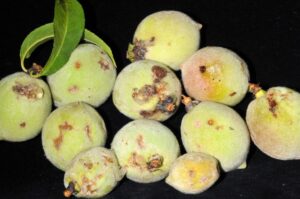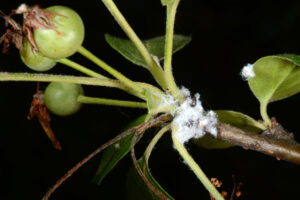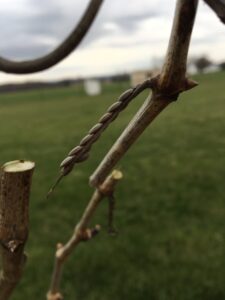Some of our readers may have small, backyard orchards, or even just a couple of fruit trees (or vines, canes, and bushes!), that you enjoy for the aesthetics and also the fruit! If you’re like me, you’re thinking that having just a few fruit trees to manage won’t be so hard, and the effort will be worth the delicious fruit you’ll have to share with your friends and family. While most information about pest management will hold true for both small and large scale orchards, something that differs is the availability of pesticides; namely, if you have just 2 or 3 fruit trees in your backyard, you’re unlikely to have access to as many pesticides as someone with a pesticide applicator’s license. So, what insecticides are available to backyard fruit growers, who may not have an applicator’s license? In this issue, I’ll highlight some integrated pest management tips in fruit production, as well as insecticide options that are available at most home improvement/gardening stores.
First-things-first: Scout and use monitoring tools before you spray to help you detect and identify potential fruit pests. We all know insecticides are good at killing insects, but they also incur an economic and environmental cost. Although it is often necessary to spray fruit trees, vines, canes, bushes, etc, to protect fruit from insect pests, using monitoring tools, like pheromone traps or sticky traps, can help you detect pests and determine when it is time to spray, so you don’t spray more than necessary. Also, ensuring you know the signs and symptoms of insects and their damage (see previous issue!), will help you identify the pest and choose the best product to stop it in its tracks.
When a spray is needed, which kind of insecticide is best for your needs? Regardless of the kind of fruit you’re growing, there are generally three kinds of insecticide products you can find: organic insecticides, which are naturally-derived products made from plant extracts or bacteria; inorganic products, which are made from chemicals that don’t contain carbon, and synthetic insecticides, which are created using man-made chemicals. Some important differences between each of these types of insecticides in terms of their use are: 1) their specificity: some are broad spectrum and will kill many kinds of insects (even good ones!), while some are very specific and kill only one kind of insect, and 2) their residual activity: some are effective against pests for a longer period of time and hold up to rain or ultraviolet (UV) light better.
I’ve listed some examples below of insecticides in each category that you can typically find in home improvement/gardening stores (Figure 1). These products may be available for use as a foliar spray, a dust/powder, or a soil-applied drench:
Organic insecticides (naturally-derived active ingredients): Pyrethrum, Neem, Bacillus thuringiensis (commonly called Bt), Spinosad.
Inorganic insecticides (active ingredients are not carbon based): Sulfur, Kaolin clay, Horticultural oils, Insecticidal soap, Boric acid, Diatomaceous earth
Synthetic insecticides (man-made active ingredients): Pyrethoids, Organophoshates, Carbamates, Neonicotinoids, etc.

Figure 1. Examples of organic (A), inorganic (B), and synthetic (C) insecticides you can find at most home improvement/gardening stores for use against insect pests on fruit.
Tips for choosing the appropriate product for insect pests. Many insecticides that you will find in home improvement/gardening stores must come into direct contact with the insect pest to kill it. This means that you need to have the product in place a bit before and during the time that the pest is active and good coverage is key! A key exception are the Bt products, which are specific to caterpillars (and some beetles) – these must be ingested by the insect to kill it. However, if the insect is already inside the plant part or fruit, Bt products applied to the outside surface will have no effect against the pest. Finally, when considering an insecticide for a fruit insect pest, keep in mind that some are more effective against piercing-sucking pests, like aphids, while others are more effective against chewing pests, like beetles or caterpillars. Also note that some products advertised for use in the orchard may be a combination of a fungicide and an insecticide. So, please always read the label carefully and in its entirety to make sure the pest you are targeting is listed on the label. Otherwise you may be applying a product that won’t take care of the problem. If you have questions or want feedback on whether a product will be effective and safe to use on your backyard fruit trees/plants, reach out to your local county extension educator!
Answers to “insect signs and symptoms” images from the previous issue of Facts for Fancy Fruit (Issue 23-04). I asked our readers to put on their insect detective hats and determine if the images below are examples of signs or symptoms. Read on below to get the full scoop!

Figure 1. Sign or symptom? Hint: these are peaches
Answer. This is a symptom. The oozing wounds on these immature peaches are symptoms of damage by larvae (caterpillars) of the Oriental fruit moth.

Figure 2. Sign or symptom? Hint: this is crabapple
Answer. This is a sign. This white, fuzzy-looking residue is actually a secretion produced by the woolly apple aphid, as protection from the environment and predators. If you brushed aside the white stuff, you’d spot the purplish-colored aphids.

Figure 3. Sign or symptom? Hint: this is apple
Answer. This is a symptom. The curling leaves of this apple tree are symptoms of feeding by the rosy apple aphid, which injects a toxin while feeding that causes leaf curl. Sometimes, you can pull the leaves back and spot the aphids in the act!

Figure 4. Sign or symptom? Hint: this is grapevine
Answer. This is a sign. This was a tricky one though, and one that stumped me when I was asked to help identify the issue! These are the eggs of a katydid, laid on a grape cane at some point. Many thought they were scale insects!